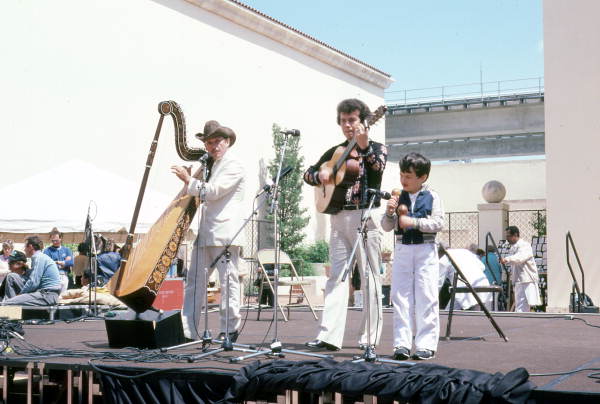 |
| Jesus Rodriguez 11" x 6.75" oil on wood, 2011 |
When I moved to Ohio from the Netherlands 14 years ago, I moved to a state with a very rich history in music. Pere Ubu from Cleveland, King Records from Cincinnati, Rahsaan Roland Kirk born in Columbus, to name a few, are just the tip of the iceberg securing Ohio an important place in the history of recorded (popular) music. It meant a lot to me. This year I left Ohio for Florida. Florida doesn't have a musical history like Ohio does. The move was clearly motivated by different motives (like the beaches, endless summers, to state the obvious). Among the people living around me in Fort Myers, there's not much of an interest in musical history, sure people like to dance, sure people like to hear music they like, and sure people play instruments like they do up north, but it's a different musical universe, music is entertainment, not at all very serious. That said I received 5 complimentary CD's in the mail from the Florida Folklife Institute, for the most part recorded during the annual Florida Folk Festival in White Springs. One CD is dedicated to bluegrass, one to blues (with the beautiful title Where the Palm Trees Shake at Night), one to African American religious music, while the other two are compilations, a mix of the first three plus some miscellaneous categories. Within these miscellaneous categories the most interesting music can be found; we hear Seminole Billy Bowlegs III (named after the famous chief Billy Bowlegs, after whom the creek behind our house is named, we live at the very location the Seminoles surrendered in the 1800s), a song recorded by the famous writer (and folklorist) Zora Neale Hurston, and children's playing songs. But the first musician to hit a home run is the Venuzuelan American harpist Jesus Rodriguez. My favorite parts of the compilation CD's are the various performers whose language is Spanish.
The Florida Folklife Collection CD's are issued by a state institution. Everything is documented out the ying-yang as you would expect from an official source. My wife is in the middle of obtaining a degree in library science so I pick up more information about cataloging than I could ever dream of. Searching for a photo of Jesus Rodriguez lead me back to the very same official Florida site as I found the complimentary CD's on. Every single photograph –and there are hundreds, just in the music section roughly parallel with the 5 CD's– is named, numbered, credited, dated, located, categorized, sub-categorized, and sub-sub-categorized. Five photos from the concert in which Jesus Rodriguez played his El Gavilan Cjaropo are published on line and they're pretty much all the same photo but every single one comes with a full page of data. Just for the sheer scale of the documentation (and the enormous effort by the cataloging staff) I reproduce here the information coming with the photograph I used for my painting. (This time I strayed far away from the photo, it is hardly the same image any more.) What would it look like then to transfer and edit this information into cataloging my painting of Jesus Rodriguez? A bigger file yet than the one following I'm afraid. A numbering system I have in place: The painting of Jesus Rodriguez will be Top 100 2011, #... — blanks to be filled in after February 2012 when the list of 100 songs is complete.

Title
- Jesus Rodriguez playing the Venezuelan harp at the Traditions Festival - Miami, Florida
Image Number
- FA5871
Year
- 1986
Date Note
- Photographed on March 22 or 23, 1986.
Series Title
- General: Folklife Collection.
- Specific: Folklife Collection Series 1667, Bureau of Florida Folklife Programs Florida Folklife Archives Florida Folklife fieldwork photographs, slides, and negatives: Traditions Festival, Folder 1 of 2 ; Box 2, FF1
- The other musicians are unidentified.
General Note
Photographer
Physical Description
- 1 slide - col - 35 mm.
Subject Term
- Festivals--Florida--Dade County--Miami
- Manners and customs
- Recreation--Florida--Dade County--Miami
- Performing arts--Florida--Dade County--Miami
- Hispanic American men--Florida--Dade County--Miami
- Hispanic American children--Florida--Dade County--Miami
- Entertainers--Florida--Dade County--Miami
- Folk musicians--Florida--Dade County--Miami
- Performances
- Musical instruments--Latin America
- Stringed instruments
- Plucked instruments
- Harp
- Harpists
- Guitar
- Guitarists
- Instrumentalists
- Music--Performance
- Folk music--Latin America
- Arts (Performing)--Florida--Dade County--Miami
- Songs, Ethnic
- Musical traditions, Latin American and Caribbean
- Ethnicity, Venezuelan
- Ethnicity, Latin American and Caribbean
- Practices
- Community rites--Florida--Dade County--Miami
- Belief and custom
- Secular festivals--Florida--Dade County--Miami
Geographic Term
Personal Subject
Subject Coporate
Subject Meeting
Shelf Number
- Shelf number: SNS1667B2F1.
No comments:
Post a Comment